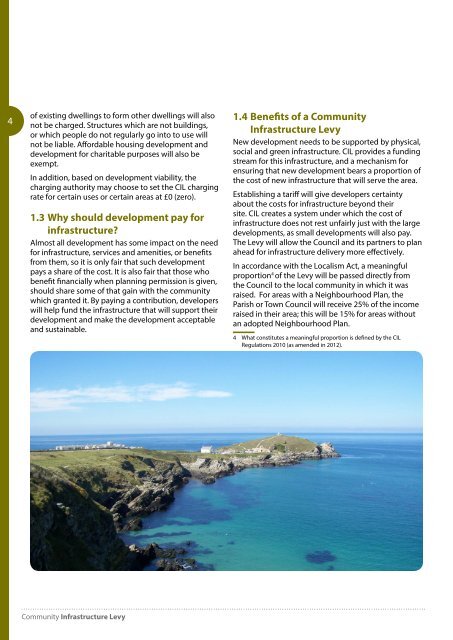Community Infrastructure Levy
2xa2u6
2xa2u6
Create successful ePaper yourself
Turn your PDF publications into a flip-book with our unique Google optimized e-Paper software.
4<br />
of existing dwellings to form other dwellings will also<br />
not be charged. Structures which are not buildings,<br />
or which people do not regularly go into to use will<br />
not be liable. Affordable housing development and<br />
development for charitable purposes will also be<br />
exempt.<br />
In addition, based on development viability, the<br />
charging authority may choose to set the CIL charging<br />
rate for certain uses or certain areas at £0 (zero).<br />
1.3 Why should development pay for<br />
infrastructure?<br />
Almost all development has some impact on the need<br />
for infrastructure, services and amenities, or benefits<br />
from them, so it is only fair that such development<br />
pays a share of the cost. It is also fair that those who<br />
benefit financially when planning permission is given,<br />
should share some of that gain with the community<br />
which granted it. By paying a contribution, developers<br />
will help fund the infrastructure that will support their<br />
development and make the development acceptable<br />
and sustainable.<br />
1.4 Benefits of a <strong>Community</strong><br />
<strong>Infrastructure</strong> <strong>Levy</strong><br />
New development needs to be supported by physical,<br />
social and green infrastructure. CIL provides a funding<br />
stream for this infrastructure, and a mechanism for<br />
ensuring that new development bears a proportion of<br />
the cost of new infrastructure that will serve the area.<br />
Establishing a tariff will give developers certainty<br />
about the costs for infrastructure beyond their<br />
site. CIL creates a system under which the cost of<br />
infrastructure does not rest unfairly just with the large<br />
developments, as small developments will also pay.<br />
The <strong>Levy</strong> will allow the Council and its partners to plan<br />
ahead for infrastructure delivery more effectively.<br />
In accordance with the Localism Act, a meaningful<br />
proportion 4 of the <strong>Levy</strong> will be passed directly from<br />
the Council to the local community in which it was<br />
raised. For areas with a Neighbourhood Plan, the<br />
Parish or Town Council will receive 25% of the income<br />
raised in their area; this will be 15% for areas without<br />
an adopted Neighbourhood Plan.<br />
4 What constitutes a meaningful proportion is defined by the CIL<br />
Regulations 2010 (as amended in 2012).<br />
<strong>Community</strong> <strong>Infrastructure</strong> <strong>Levy</strong>


